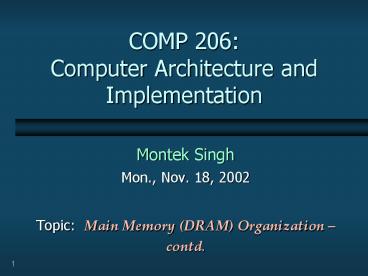COMP 206: Computer Architecture and Implementation PowerPoint PPT Presentation
Title: COMP 206: Computer Architecture and Implementation
1
COMP 206Computer Architecture and Implementation
- Montek Singh
- Mon., Nov. 18, 2002
- Topic Main Memory (DRAM) Organization contd.
2
Achieving Higher Memory Bandwidth
Fig. 5.27HP3
3
Improving Memory Chip Performance
- Several techniques to get more bits/sec from a
DRAM chip - Allow repeated accesses to the row buffer without
another row access time - burst mode, fast page mode, EDO mode,
- Simplify the DRAM-CPU interface
- add a clock to reduce overhead of synchronizing
with the controller - synchronous DRAM (SDRAM)
- Transfer data on both rising and falling clock
edges - double data rate (DDR)
- Each of the above adds a small amount of logic to
exploit the high internal DRAM bandwidth
4
Conventional DRAM Architectures
16 Mb (16M?1) chip One 4096?4096 array of data
bits
16 Mb (1M?16) chip 16 1024?1024 arrays of data
bits
- Interface is either the original asynchronous
interface or one of the many recent minor
modifications of it - RAS Row Address Strobe
- CAS Column Address Strobe
- DRAM asynchronously controlled by processor
5
Basic Mode of Operation
- Slowest mode
- Uses only single row and column address
- Row access is slow (60-70ns) compared to column
access (5-10ns) - Leads to three techniques for DRAM speed
improvement - Getting more bits out of DRAM on one access given
timing constraints - Pipelining the various operations to minimize
total time - Segmenting the data in such a way that some
operations are eliminated for a given set of
accesses
6
Nibble (or Burst) Mode
RAS ---- ---- ---- ---- ---- ---- ---- ---- ----
CAS CAS CAS CAS RA CA D1 D2 D3 D4
- Several consecutive columns are accessed
- Only first column address is explicitly specified
- Rest are internally generated using a counter
7
Fast Page Mode
RAS ---- ---- ---- ---- ---- ---- ---- ---- ----
CAS CAS CAS CAS RA CA1 CA2 CA3 CA4 D1
D2 D3 D4
- Accesses arbitrary columns within same row
- Static column mode is similar
8
EDO Mode
RAS ---- ---- ---- ---- ---- ---- ---- ---- ----
CAS CAS CAS CAS CAS CAS CAS RA CA1 CA2 CA3 CA4 C
A5 CA6 CA7 D1 D2 D3 D4 D5 D6
- Arbitrary column addresses
- Pipelined
- EDO Extended Data Out
- Has other modes like burst EDO, which allows
reading of a fixed number of bytes starting with
each specified column address
9
Evolutionary DRAM Architectures
- SDRAM (Synchronous DRAM)
- Interface retains a good part of conventional
DRAM interface - addresses multiplexed in two halves
- separate data pins
- two control signals
- All address, data, and control signals are
synchronized with an external clock (100-150 MHz) - Allows decoupling of processor and memory
- Allows pipelining a series of reads and writes
- Peak speed per memory module 800-1200 MB/sec
10
Revolutionary DRAM Architectures
- Examples
- RDRAM (Rambus DRAM)
- MDRAM (MoSys DRAM)
- Salient features
- Many smaller memory banks interleaved on one chip
- Protocol based architecture
- Narrow, fully multiplexed communication protocol
- Example RAMBUS (RDRAM, DRDRAM)
- Each chip is more like a memory system than a
component - Interleaved memory and a high-speed interface
- Packet-switched bus (split transaction bus)
- Chip can return variable bytes from a single
request, performs own reset, transfers on both
clock edges - Narrow bus (1-2 data bytes)
- Upto 3 transactions can be done concurrently
- Internally, 72-bit wide bus with 5 ns cycle time
- Up to 1600 Mbps peak bandwidth
- Expensive!
11
Other types of Memory
- ROM Read-only Memory
- Flash ROM which can be written once in a while
- Used in embedded systems, small microcontrollers
- Offer IP protection, security
12
Memory Interleaving
- Goal Try to take advantage of bandwidth of
multiple DRAMs in memory system - Memory address A is converted into (b,w) pair,
where - b bank index
- w word index within bank
- Logically a wide memory
- Accesses to B banks staged over time to share
internal resources such as memory bus - Interleaving can be on
- Low-order bits of address (cyclic)
- b A mod B, w A div B
- High-order bits of address (block)
- Combination of the two (block-cyclic)
13
Low-order Bit Interleaving
14
Mixed Interleaving
- Memory address register is 6 bits wide
- Most significant 2 bits give bank address
- Next 3 bits give word address within bank
- LSB gives (parity of) module within bank
- 6 0001102 (00, 011, 0) (0, 3, 0)
- 41 1010012 (10, 100, 1) (2, 4, 1)

